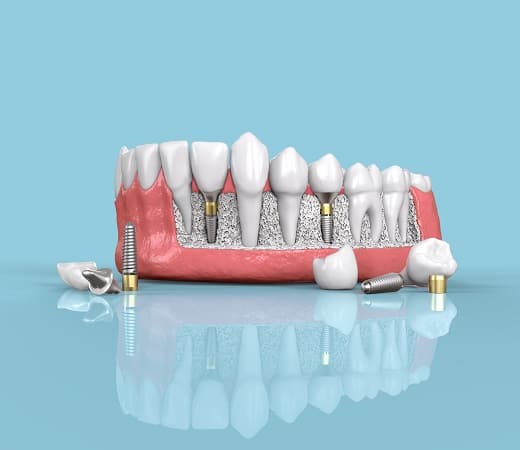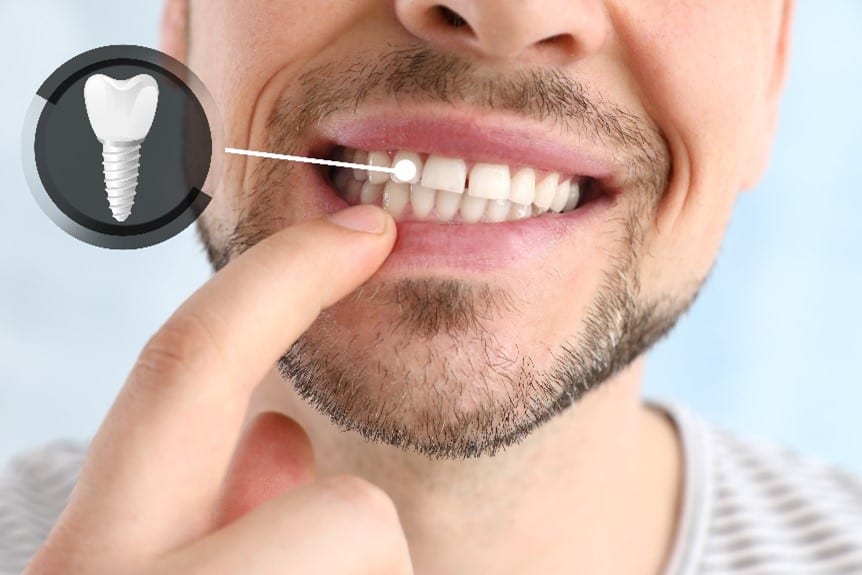
Dental Bone Loss Treatment in Seattle

Implants Are Capable of Halting Bone Loss.
“Dental implants are preferred for tooth replacement thanks to a number of factors, and are the only option capable of preserving bone health and arresting deterioration. Bone loss in the jaw is caused by conditions like:
- Periodontal Disease
- Tooth Loss
- Misaligned Teeth
- Ill-Fitting Appliances
- Injury or Trauma
- Cysts or Tumors

Implants rely on sufficient bone volume for support, and stimulate surrounding bone tissue each time the teeth bite or chew – an important component of maintaining bone health. Seattle patients with bone loss often are not candidates for implants right away at Pacific Northwest Periodontics, yet may still enjoy the benefits of this tooth replacement method following bone stabilization dental services. Total implant cost may take into account any preparatory procedures needed to restore bone health.
Symptoms of Bone Loss in the Jaw
Signs that a patient’s jawbone may be deteriorating include:
- Teeth that feel loose or are shifting out of place
- Sensitive teeth
- Bleeding gums
- Significant oral pain
- Halitosis (bad breath)
While these symptoms may be indicative of a problem other than bone loss, they still warrant attention from a periodontist for proper diagnosis and treatment.
Dental Bone Loss

As with any dental procedure, there is a possibility of unintended collateral damage while placing your dental implants. However, due to our experience and knowledge, we are able to prevent issues like periodontal disease, tooth loss, or misaligned teeth by implementing advanced procedures like bone grafting and ridge augmentation. Contact us for a consultation so we can determine exactly what procedures you need.
Bone Grafting
Adds bone to areas in deficit to strengthen teeth or enable implant placement.
Ridge Augmentation
Replenishes volume and stability of the bony arch following tooth and bone loss, to reestablish facial contour and prepare for full-arch tooth replacement.
Ridge Preservation
Preserves an extraction site by adding bone tissue into the exposed tooth socket (allows for future or immediate implant placement).
Sinus Lift
Enables implant placement in upper molar and premolar regions by thickening bone in or around the maxillary sinus cavity.
Guided Tissue Regeneration
Utilizes barrier membranes to expedite healing and new tissue growth following bone stabilization services.
Cost of Treating Bone Loss

The total price depends on the course of treatment the patient and doctor agree is appropriate. During a consultation at Pacific Northwest, the periodontist can provide a complete quote so the patient knows what to expect. Some insurance plans may cover some of the costs associated with addressing bone loss, but many do not. Our team can help patients review their policies to see what coverage they may be entitled to. Financing options are available for patients who prefer to make payments toward the total cost of care.
Experience Matters
A member of the American Academy of Osseointegration and American Dental Association, among other respected organizations, Dr. Darrin Rapoport remains committed to advancing bone health through proven, effective technologies and life-changing results. His extensive experience and background in both general dentistry and periodontics afford him a keen perspective on oral health improvement, providing a unique advantage for our patients.
For a consultation, please request an appointment online or call (206) 575-1086 for the Tukwila office.
Bone Loss FAQ
Why does the jawbone weaken after a tooth falls out?
Any bone that does not get used becomes weaker over time. Whenever a person chews or smiles, the teeth put necessary pressure on the jawbone. Without a tooth to stimulate an area of the jawbone, the bone gradually deteriorates. Dental implants correct this problem by simulating the effects of tooth roots, applying the proper amount of force on the bone so the jaw remains robust.
How soon after losing a tooth do I need to worry about bone loss?
Some patients choose to procrastinate on replacing a missing tooth, particularly when it is not at the center of their smile. However, our periodontists strongly advise against postponing treatment since bone loss can occur rapidly. Many patients see about one quarter of their jawbone in the area lost within the first year alone. A dental implant is very effective at stopping the resorption process.
If I have a missing tooth, can I protect my bone health without getting a dental implant?
Alternative treatments like dental bridges and partial dentures can help fill in gaps left by missing teeth, but they do nothing to prevent jawbone erosion because they do not apply pressure to the bone. Although dental implants cost more than bridges and partials, they are undoubtedly the better choice for the long-term health of the mouth.
Are treatments for bone loss painful?
No. Patients are kept comfortable during their procedure with a numbing agent, laughing gas or anesthesia. Afterwards, patients experience some moderate discomfort like sore gums, but that can be alleviated with pain medication.
What are the risks associated with bone grafting?
Patients typically experience mild side effects while recovering from bone grafting, which include swollen gums, minor bleeding and some difficulty eating and speaking. Major complications are very rare, but it is possible for a patient to develop an infection or nerve injury. There is also a low risk of the body rejecting or reabsorbing the bone graft. If that occurs, our periodontists can plan an alternative treatment for strengthening the jawbone and replacing gaps in the smile.



